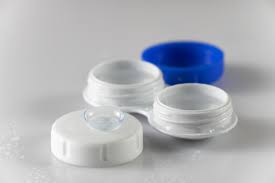What are Contact Lenses?
A contact lens is a thin, curved and transparent disc-shaped device made of high-quality materials that are usually silicone hydrogel or rigid gas permeable (RGP) materials. It is precisely shaped to fit over the cornea which is the clear front surface of the eye and correct vision problems such as nearsightedness, farsightedness, astigmatism and presbyopia.

How Do Contact Lenses Work?
Contact lenses work by modifying the way light enters the eye which compensates it for any refractive errors in the eye’s natural lens or cornea. When light passes through the contact lens it is refracted or bent to focus correctly on the retina at the back of the eye resulting in clear and sharp vision.
Contact lenses can correct various vision conditions:
- Nearsightedness (Myopia): Contact lenses for nearsightedness help focus light further back in the eye compensating for the elongated shape of the eyeball.
- Farsightedness (Hyperopia): Contact lenses for farsightedness help bring light forward compensating for the shorter shape of the eyeball.
- Astigmatism: Contact lenses for astigmatism are designed with different powers in different meridians of the lens. This helps to correct the irregularly shaped cornea and provide clear vision.
- Presbyopia: Contact lenses for presbyopia have multifocal designs incorporating different optical powers to address both near and distant vision allowing wearers to see clearly at various distances.
Benefits of Contact Lenses
Contact lenses offer numerous benefits that make them a popular choice for vision correction:
1. Natural and Unobstructed Vision
Contact lenses provide a wider field of view compared to eyeglasses by allowing more natural and peripheral vision. They move with your eyes providing a more natural visual experience.
2. Enhanced Aesthetics
Contact lenses offer an aesthetic advantage as they are virtually invisible when worn. They allow your natural beauty to shine through without any frame or lens obstruction.
3. Active Lifestyle Freedom
Contact lenses provide greater freedom for active individuals or those who engage in sports or physical activities. Unlike glasses, they don’t fog up, slip down the nose or get in the way during physical activities.
4. Flexibility and Variety
Contact lenses come in various types and designs catering to different vision needs and preferences. Whether you prefer daily disposables, monthly lenses, toric lenses for astigmatism or multifocal lenses there is a contact lens option available for you.
5. Compatibility with Fashion and Style
Contact lenses offer the flexibility to experiment with different looks, styles and even eye colors. Colored contact lenses allow wearers to change or enhance their natural eye color providing an exciting opportunity for self-expression.
Different Types of Contact Lenses
Following are the types of contact lens:
1. Soft Contact Lenses
Soft contact lenses are the most common and widely used type of contact lenses. They are made of a soft, flexible plastic material that allows oxygen to pass through to the cornea ensuring comfort and eye health. Soft contact lenses are available in different variations including:
– Daily Disposable Lenses
Daily disposable lenses are designed to be worn for a single day and then discarded. They offer the ultimate convenience as there is no need for cleaning or maintenance. Daily disposables are ideal for individuals with allergies or those who prefer a hassle-free lens-wearing experience.
– Monthly Disposable Lenses
Monthly disposable lenses are replaced once a month offering a cost-effective option for regular contact lens wearers. These lenses require proper cleaning and storage in a lens solution when not in use.
– Extended Wear Lenses
Extended wear lenses are designed to be worn continuously for an extended period usually up to several days or nights. They are made of highly breathable materials allowing for overnight wear without compromising eye health. However, it’s crucial to follow your eye care professional’s recommendations and practice proper hygiene when using extended wear lenses.
2. Rigid Gas Permeable (RGP) Contact Lenses
Rigid gas permeable (RGP) contact lenses are also known as hard lenses made of a durable plastic material that allows oxygen to pass through to the cornea. These lenses provide excellent vision correction and are known for their durability and long lifespan. While they may require a short adjustment period RGP lenses offer advantages such as:
- Crisp and clear vision
- Higher resistance to deposits and lens debris
- Better durability and longer lifespan compared to soft lenses
- Ideal for individuals with astigmatism or certain corneal irregularities
3. Toric Contact Lenses
Toric contact lenses are specifically designed to correct astigmatism which is a common condition that causes blurred or distorted vision due to an irregularly shaped cornea. These lenses have different powers in different meridians of the lens allowing them to align with the astigmatism axis for clear and stable vision. Toric lenses are available in both soft and RGP materials catering to individual preferences and needs.
4. Multifocal Contact Lenses
Multifocal contact lenses are a great option for individuals with presbyopia which is a condition that typically occurs with age and leads to difficulty in focusing on close-up objects. These lenses have multiple zones with different powers enabling clear vision at various distances. Multifocal contact lenses can be either soft or RGP offering flexibility and convenience for those who need multifocal correction.
5. Colored Contact Lenses
Colored contact lenses are a popular choice for individuals who wish to enhance or change the appearance of their eye color. These lenses are available with or without vision correction and offer a wide range of color options allowing wearers to experiment with different looks and styles.
Contact lenses have revolutionized vision correction, providing a comfortable and convenient alternative to traditional eyeglasses. With their ability to correct a wide range of vision conditions and their numerous benefits, contact lenses offer wearers improved visual acuity, enhanced aesthetics.






